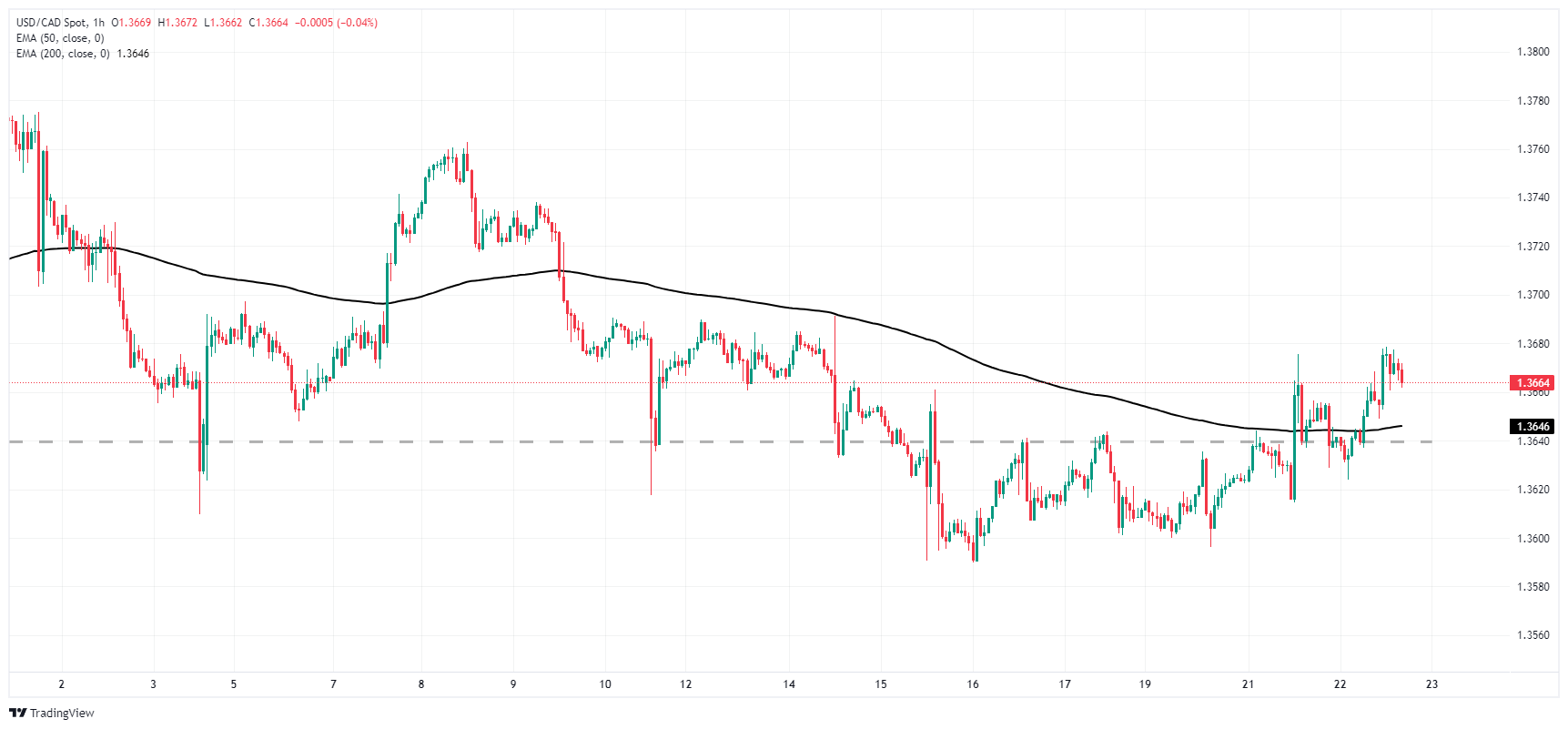- The Canadian Dollar weakens overall as the CAD loses its defensive stance.
- In Canada, only low-level data will be released until retail sales on Friday.
- US Home Sales Disappoint, Fitch Warns of Persistent Inflation.
The Canadian Dollar (CAD) fell on Wednesday as broader market sentiment weakened. This dragged the CAD lower and sent bids towards the US Dollar (USD). The Canadian Dollar fell to its lowest price against the Dollar in a week, leading the Dollar to its third consecutive gain against the CAD.
Canada will offer strictly mid-level data for the rest of the week, and CAD investors will have to wait until Friday for Canadian Retail Sales for March. US data will be the key for the rest of the week.
Daily summary of market movements: Canadian dollar retreats, USD finds room to rise
- Minutes from the latest Federal Reserve (Fed) meeting will be released on Wednesday, and investors will look for signs of a dovish bias in the Federal Open Market Committee's (FOMC) internal dialogue on interest rates.
- US existing home sales fell for the second consecutive month to 4.14 million, below the forecast of 4.21 million and below the previous 4.22 million (revised slightly upward from 4.19 million).
- Fitch Ratings warned on Wednesday that services inflation around the world is likely to remain persistent. The ratings agency warned that price persistence will likely slow the pace of rate cuts.
- US Purchasing Managers' Index (PMI) data will be released on Thursday, and investors expect it to remain stable.
- Canadian retail sales and US durable goods orders will close out the week on Friday.
Canadian Dollar PRICES Today
The following table shows the percentage change of the Canadian Dollar (CAD) against the currencies listed today. The Canadian Dollar was the strongest currency against the Australian Dollar.
| USD | EUR | GBP | JPY | CAD | AUD | NZD | CHF | |
|---|---|---|---|---|---|---|---|---|
| USD | 0.11% | -0.27% | 0.22% | 0.05% | 0.39% | -0.31% | 0.33% | |
| EUR | -0.11% | -0.37% | 0.08% | -0.03% | 0.28% | -0.41% | 0.19% | |
| GBP | 0.27% | 0.37% | 0.48% | 0.29% | 0.66% | -0.04% | 0.58% | |
| JPY | -0.22% | -0.08% | -0.48% | -0.18% | 0.16% | -0.51% | 0.09% | |
| CAD | -0.05% | 0.03% | -0.29% | 0.18% | 0.34% | -0.31% | 0.25% | |
| AUD | -0.39% | -0.28% | -0.66% | -0.16% | -0.34% | -0.67% | -0.06% | |
| NZD | 0.31% | 0.41% | 0.04% | 0.51% | 0.31% | 0.67% | 0.59% | |
| CHF | -0.33% | -0.19% | -0.58% | -0.09% | -0.25% | 0.06% | -0.59% |
The heat map shows the percentage changes of the major currencies against each other. The base currency is chosen in the left column, while the quote currency is chosen in the top row. For example, if you choose the Canadian Dollar in the left column and move down the horizontal line to the US Dollar, the percentage change in the box will represent CAD (base)/USD (quote).
Technical analysis: The Canadian dollar gives up another fifth against the dollar
The Canadian dollar (CAD) fell overall on Wednesday, falling four tenths against the New Zealand dollar (NZD) and the British pound (GBP). However, the CAD rose a quarter of a percent against the Australian Dollar (AUD), as the Australian Dollar fell to the bottom of the chart in the mid-week market session.
USD/CAD is heading for its third consecutive daily rise, while the pair consolidates a technical recovery from the 50-day EMA at 1.3637. The 1.3640 level remains a key technical barrier, and buyers will look to launch another leg higher if bids fall back to the middle zone.
The daily candles continue to hold on the north side of the 200-day EMA at 1.2550, maintaining the bullish stance of the Dollar against the Canadian Dollar.
USD/CAD hourly chart
USD/CAD daily chart
The Canadian Dollar FAQs
The key factors that determine the price of the Canadian Dollar (CAD) are the level of interest rates set by the Bank of Canada (BoC), the price of oil, Canada's main export product, the health of its economy, inflation and the trade balance, which is the difference between the value of Canadian exports and its imports. Other factors are market confidence, that is, whether investors bet on riskier assets (risk-on) or look for safe assets (risk-off), with the risk-on being positive for the CAD. As its largest trading partner, the health of the US economy is also a key factor influencing the Canadian dollar.
The Bank of Canada (BoC) exerts significant influence over the Canadian Dollar by setting the level of interest rates that banks can lend to each other. This influences the level of interest rates for everyone. The BoC's main objective is to keep inflation between 1% and 3% by adjusting interest rates up or down. Relatively high interest rates are usually positive for the CAD. The Bank of Canada can also use quantitative easing and tightening to influence credit conditions, with the former being negative for the CAD and the latter being positive for the CAD.
The price of oil is a key factor influencing the value of the Canadian Dollar. Oil is Canada's largest export, so the price of oil tends to have an immediate impact on the value of the CAD. Generally, if the price of oil rises, the CAD also rises, as aggregate demand for the currency increases. The opposite occurs if the price of oil falls. Higher oil prices also tend to lead to a higher probability of a positive trade balance, which also supports the CAD.
Although inflation has traditionally always been considered a negative factor for a currency, as it reduces the value of money, the opposite has actually happened in modern times, with the relaxation of cross-border capital controls. Higher inflation often leads central banks to raise interest rates, attracting more capital inflows from global investors looking for a lucrative place to store their money. This increases the demand for the local currency, which in the case of Canada is the Canadian Dollar.
The published macroeconomic data measures the health of the economy and may have an impact on the Canadian dollar. Indicators such as GDP, manufacturing and services PMIs, employment and consumer confidence surveys can influence the direction of the CAD. A strong economy is good for the Canadian dollar. Not only does it attract more foreign investment, but it may encourage the Bank of Canada to raise interest rates, resulting in a stronger currency. However, if economic data is weak, the CAD is likely to fall.
Source: Fx Street
I am Joshua Winder, a senior-level journalist and editor at World Stock Market. I specialize in covering news related to the stock market and economic trends. With more than 8 years of experience in this field, I have become an expert in financial reporting.







